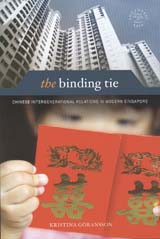-
In her new book, The Binding Tie: Chinese Intergenerational Relations in Modern Singapore, Kristian Goransson explores the parallel forces binding generations together and threatening continuity across generations in contemporary Singapore. The book first introduces a short history of Singapore related to the identities of migrant Chinese, indicating that neither Mandarin nor English is historically representative of Chinese cultural life in Singapore. It is fair enough to say that the author argues that that language shift from dialects to Mandarin and English in contemporary Singapore is not only a result of state intervention, but it also induces a shift in identity and social status.
-
Goransson analyses familial or generational relationships within the context of state and larger political economies. The focus on family is an essential starting point. Family is not only the cornerstone of the government's Asian values, as the author emphasised throughout the book, but also the social foundation of a society in both Confucius ideology and ordinary people's mindset. The author demonstrates how the Singaporean government employs powerful tools (language usage in this case) to implement social-engineering schemes to regulate the population, which redefine the cultural heritage of the Chinese community and break, to some extent, intergenerational ties. The argument that the state's intervention in private life sustains the continuity of intergenerational binds is well grounded.
-
In addition, specific ways in which elder and younger generations are tied together are also revealed. The concept of 'intergenerational contract' is fundamental in explaining how intergenerational expectations and obligations are challenged, reworked and reaffirmed in relation to the extensive societal change. Goransson defines intergenerational contract as 'a metaphor for norms of intergenerational obligations and expectations' that binds generations together, and states that it is not a contract agreed upon between equals but one that the parties are socialised into (pp. 9–13). Throughout the book, Goransson contextualises the intergenerational contract in the socialisation of notions of indebtedness to the authority of one's parents, including clearly-defined obligations both in verbal accounts as well as in actions. More importantly, it is pointed out that 'intergenerational obligations and expectations go in both directions' (pp. 148–51).
-
The concept of contract is represented as a lived tradition in the book. The idea that children are responsible for providing support for their elderly parents is taken as given. Such support is often manifested in monetary forms and gifts, which, in turn, reaffirm intergenerational roles?relationships as well as the intergenerational contract. Today, both older and younger generations continue to invest in, as well as benefit from, the implicitly understood contract.
-
At the same time, the author insightfully explores the cultural meaning of money and its important symbolic significance (pp. 110–11). Monetary transferring and gifts not only function 'as a binding agent in terms of economic-practical support, but also as an important marker of reciprocity and affection' (p. 109). '[T]ransactions of money, goods and services have a regenerating effect on intergenerational relations that goes beyond purely material survival' (p. 114); gifts from adult children to parents can be regarded as social investments as Yan Yunxiang observed in northern China[1] and as a kind of 'compelling obligation,' to use Mauss' term,[2] deriving from generational bonds and expressions of fidelity. The author finds out that parent-child relationships 'have become less hierarchal and more reciprocal,' and families 'carefully negotiate their obligations' (p. 160).
-
The author successfully locates the binding agent 'in the culture of intergenerational obligations and expectations?not only in relations to the political economy and the state, but also in relation to a specific cultural logic whereby it is represented and interpreted' (p. 160). The book concludes that 'the notion of a contract is relevant in understanding both the strategies people employ in relation to the political economy and the lack of public welfare, and the cultural logic of intergenerational roles and responsibilities' (p. 159).
-
All in all, the book is clearly written and carefully structured. If there is any room for improvement, it would be the discussion of the state and the substantial depiction of in-depth fieldwork data. Firstly, it must be pointed out that the minimal role of the state in providing senior population welfare lies in its historical background and cultural logic. The care of the elderly has never been the responsibility of the state in history or in Chinese religious doctrines, since Confucius' ideal of the state is welfareless in a 'modern' sense and that of the family is supportive of the state (rather than being an equal component in a family-state dichotomy). So, the government's family policies simply reinforced a long-cherished Confucius ideology of, and interrelationship between, family and the state. Keeping these in mind, it is more challenging to understand 'why there is continued emphasis on the family,' and what challenges 'antiwelfare' policies taken for granted by the public will face in the future. Secondly, there are certain points where fieldwork interviews could have gone further to reveal emotional and affectional interactions among kin. I still prefer the Chinese term xiao over 'contract' for the former contains the emotional and affectionate connotations and relationships that the latter lacks.
-
Geographically- and historically-situated, this book is inspiring for both an academic and general readership who are interested in intergenerational relationships in any Chinese community.
Endnotes
[1] Yunxiang Yan, The Flow of Gifts: Reciprocity and Social Networks in a Chinese Village, Place: Stanford University Press, 1996.
[2] Marcel Mauss, The Gift: The Form and Reason for Exchange in Archaic Societies Place: W. W. Norton & Company, Inc., 1967.
|



